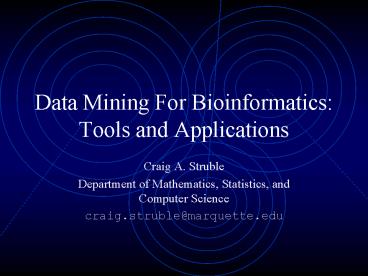Data Mining For Bioinformatics: Tools and Applications - PowerPoint PPT Presentation
1 / 28
Title:
Data Mining For Bioinformatics: Tools and Applications
Description:
Example: Yeast Sporulation. Chu et.al. Science 282 ... Example: Yeast Sporulation. Data Mining Tools and Applications - Craig A. Struble. 12 ... – PowerPoint PPT presentation
Number of Views:1075
Avg rating:3.0/5.0
Title: Data Mining For Bioinformatics: Tools and Applications
1
Data Mining For Bioinformatics Tools and
Applications
- Craig A. Struble
- Department of Mathematics, Statistics, and
Computer Science - craig.struble_at_marquette.edu
2
Overview
- Clustering
- Hierarchical Clustering, SOMs, Model-based
clustering - Classification
- SVMs, neural networks
- Tool building
3
Clustering
- Basic idea
- Group similar things together
- d(x,y) Distance function between x and y
- Euclidean, mismatches, etc.
- Bioinformatics context
- Similar expression profiles imply similar
function - This is under some scrutiny
- Unsupervised
- Useful when no other information is available
- Just to see what happens
4
Example Data
- Genes x Experiments
- 6000 genes x 16 experiments
- Could use ratios or other values for data
5
Hierarchical Clustering
- Bottom up (agglomerative)
- Top down (divisive)
- Linkage
- How groups are combined (or split)
6
Hierarchical Clustering (Example)
- Analyzing yeast data (different experiment)
7
Self Organizing Maps
- Also called Kohonen maps
- Example of neural networks
8
Self Organizing Maps
- Yeast data set
- Typical values
- Error bars
- Using GeneSOM in R
- Many other visualizations
9
Clustering With Models
- Create/select representative points (i.e. models)
- Perform cluster analysis (K-means, K-medoids,
etc.) - Classify/identify real data items by finding
which representative they cluster with
10
Example Yeast SporulationChu et.al. Science 282
11
Example Yeast Sporulation
12
After Clustering
- Try multiple sequence alignment of genes closely
clustered together - Include upstream/downstream sequence to look for
promoter regions, etc. - Search in KEGG for metabolic pathways genes may
be involved with - Look at functional classification of genes in the
same cluster - May be able to assign putative function to genes
with unknown function (again, this is under
scrutiny)
13
Classification
- Use data to create a classifier
- A predictive model for labeling new data items
- Supervised learning
- Generate data associated with known labels
- Train the specific technique with labeled data
14
Support Vector Machines
- Find a hyperplane to separate data points
15
Feature Selection
- Identify subset of attributes as most important
- Identify group of genes that play most important
role in distinguishing classes - Use information gain or other statistical
measures to determine the importance of a data
item - In many cases, feature selection is the true goal
16
Example Leukemia Classification
- Ovarian Cancer (Furey et al, 2000)
- Also tested on Leukemia data (Golub et al, 1999)
- 97,802 DNA clones used
- 31 tissue samples
- Cancerous and normal ovarian tissue
- Non-ovarian tissue
17
Example (cont.)
- Feature selection
- High scoring genes differ most on average and
have small deviations in value - 50 relevant clones identified
- Leave one out testing
- 80 accuracy
- Really testing if selected features are good
18
Neural Networks
- Network of connected neurons
- Trained with data with known output values
- Errors propogated through network for learning
Input Layer
Output Layer
Hidden Layer
19
Example Cleavage Site Prediction (Nielsen et al,
1997)
- Predict where cleavage sites are in protein
precursors - Training data from SWISS-PROT database
20
Example (cont.)
- Input layer
- Groups of 20 neurons per location
- 20 amino acids
- Sliding window of 5-39 amino acids
- Hidden layer
- 0-10 neurons tried
- Output layer
- 2 neurons per location, P(c),P(s)
- Trained with backpropogation
a
P(c)
P(s)
v
a
v
a
P(c)
v
P(s)
21
Tool Building
- Many commercial packages have lots of tools
- Not always integrated
- May not provide enough flexibility
- Sometimes youve just gotta do it yourself
22
Tool Building
- Identify problem to work on
- E.g. predict where miRNAs are on the genome
- Determine where to get data
- E.g. NCBI, KEGG, literature
- Determine the final format of your data
- E.g. Oracle, PostgreSQL, CSV, XML, etc.
- Select data mining techniques to use
- Literature and experience
23
Tool Building
- Select user interface style
- Web-based vs. applet vs. application
- Upload data/download data?
- Select visualizations
- Decide how to present the data
- Communicate with your users
24
Tool Building
- Select software to use
- Does it contain the data mining techniques to
use? - Is the source code available?
- Library vs. application vs. interpreter
- What do you know and what are you willing to
learn? - Eventually, youll build up a collection of tools
to build on
25
Typical architecture for small project
Neural Network
Output
Perl Scripts
Perl Scripts
Clustering
26
Where to Find Examples
- Search Google (http//www.google.com)
- E.g. self organizing maps bioinformatics
- Citeseer (http//citeseer.nj.nec.com/)
- PubMed (http//www.ncbi.nih.gov)
- Web pages and papers usually contain links to
software used
27
Be Prepared
- Programming for bioinformatics/data mining often
requires knowing many languages (Perl, C, Java
at a minimum) - Practice on supplied sample data sets if any
- Read, read, read!
28
Useful free tools
- R (http//www.r-project.org)
- Statistics, plotting, clustering, etc.
- Octave (http//www.octave.org)
- Matlab clone (Matlab itself is EXTREMELY useful
and popular) - PostgreSQL (http//www.postgresql.org)
- Powerful ORDBMS (when you cant afford Oracle)
- http//bistro.mscs.mu.edu/cstruble/biolinks.html































